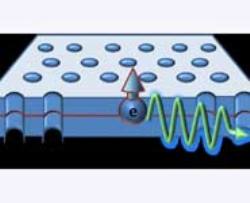Professor John Rarity and Dr Ruth Oulton from the University of Bristol’s Centre for Quantum Photonics have received a Future and Emerging Technologies grant worth €2 million from the European Commission and a CHIST-ERA award worth €1.1 million from national funding agencies in Europe.
 Artist's impression of a spin quantum memory interacting with light in a photonic device
Artist's impression of a spin quantum memory interacting with light in a photonic device
Professor John Rarity is the leader of the CHIST-ERA project titled ‘the Solid-State Quantum Network.’ The project’s major challenge is to utilize semiconductor devices on the nanoscale. Nanosized quantum dots detain a single electron that functions as a quantum repeater’s memory. These single electrons record data at a rate of one millionth of a second. This rate is adequate for two base stations that are 100 km apart to transmit the data in a single photon over a distance of 1,000 km.
Dr Ruth Oulton is the leader of the FP7 EU project titled ‘Spin Photon Angular Momentum Transfer for Quantum Enabled Technologies (SPANGL4Q).’ The project will develop novel techniques and designs for the semiconductor devices. It will devise a new technique to shift data in a single electron to a quantum dot’s nuclei, which can store data in their spin for a few seconds, which is comparatively longer than that of in electrons. This longer storage time is sufficient to transport a photon to a satellite, thus enabling a worldwide communication network.
Designing semiconductors based on the point of view of basic physics is one of the objectives of the SPANGL4Q project. The quantum devices transmit light from fiber to a tiny optical trap using photonic technology, thus enabling more efficient functioning of the memory. However, the usage of these optical traps in manipulating the spin of electrons is not clearly understood. The SPANGL4Q team will work on polarization engineering for these structures to understand the behavior of light in these structures, which in turn paves the ways to control light for numerous applications in security, medicine and telecommunications.